
Trout cause problem for Yellowstone lake
The cutthroat trout population, an important keystone species whose last stronghold is in Yellowstone Lake and its surrounding tributaries, is at an all time low.
Invasive lake trout, whirling disease caused by parasites and an unrelenting drought in the region have driven the number of cutthroat trout to the lowest figures in a century, a time when the trout were highly desirable to anglers and over-fished by park visitors.
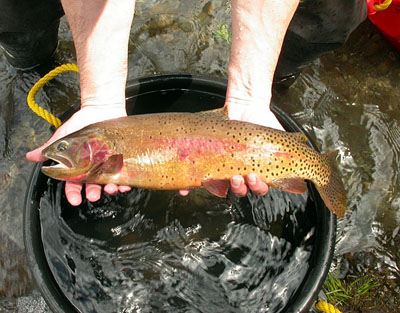 |
A Yellowstone Fisheries biologist displays a typical adult cutthroat trout (Photo courtesy of National Park Service). |
But in this story, there is no clear beginning or end. Researchers and Yellowstone National Park representatives alike cannot completely explain the real origins of, or specific solutions for, the threats posed to the cutthroat trout.
Lake trout, the first of the forces causing cutthroat numbers to dwindle, were first discovered in Yellowstone Lake in 1994, but the unwanted fish have clearly been establishing a stronghold for some years.
“No one is quite sure how lake trout came to live in Yellowstone,” said Al Nash, director of Public Affairs at Yellowstone. “It could have been intentional placement by an angler or it could have been a mistake. Whatever the case, they are certainly doing some damage now.”
And there is no more certainty about how whirling disease, a harmful sickness that can make the infected fish unhealthy and thus more vulnerable to pray or even kill it, arrived.
“It’s generally a mystery how whirling disease got into the lake,” said Dick Vincent, whirling disease coordinator for Montana. “Birds that had ingested infected fish could have spread it through their feces, fishermen could have drug parasite spores in on their dirty boots, boats or equipment. And then nature itself could be responsible. Spawning fish that are infected outside of the park could come into the park and spread it that way.”
The third and most minimal factor affecting the cutthroat trout population is the Western drought. Park representatives say they wouldn’t worry as much about the drought’s effects on levels of cutthroat in Yellowstone Lake if it weren’t for the fact that there are already two other negative forces impacting the native trout population.
| Beautiful Yellowstone Lake now hosts invasive species like lake trout and the whirling disease parasite lurking unseen (Photo courtesy of National Park Service). |
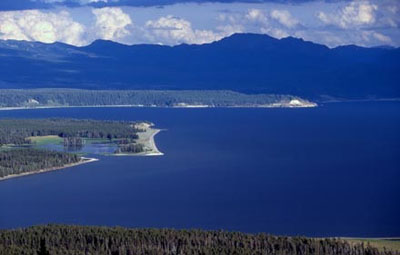 |
“Cutthroat trout are pretty short-lived as a species already,” said Pat Bigelow of the Yellowstone Fisheries Department, who is in charge of the lake trout removal effort. “They are being hit by lake trout, whirling disease and drought which makes spawning very unsuccessful, which means you’re basically in trouble. All these things are hitting the younger cutthroat so you’re not having desired survival rates or good population turnover. This can only go on for so many years before you’re out of luck.”
Though the drought may end on its own in due time, eliminating both the presence of lake trout and whirling disease in park waters is an ongoing battle with no end in sight.
“Often times when you look at dealing with the impact of some sort of invasive non-native species, you have a management technique that allows you to see some sort of end game,” said Nash. “That’s not the case with lake trout in Yellowstone Lake. We will be working aggressively to reduce the population of lake trout and its harmful effects on the cutthroat trout… but we’re never going to completely eradicate the lake trout population. There are too many and it’s a huge lake.”
Researchers and fisheries biologists are just as confused as to how and when they can slow the effects of whirling disease on the cutthroats.
“It’s hard to say how widespread the effects are going to be and how long lasting they may be,” said Vincent. “Right now there is no known way to eliminate the parasite once it gets in the water and starts affecting the fish.”
| A Yellowstone National Park ranger holds up a typical lake trout to show off its size (Photo courtesy of National Park Service). |
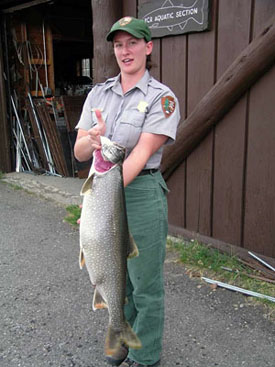 |
One may wonder why park officials, researchers, and biologists are so concerned by the threat posed to the cutthroat trout population. There are many reasons.
The cutthroat trout population has its last real stronghold in Yellowstone Lake, yet its presence is nowhere near what it used to be and could be at risk for endangerment. Though the species should surely be protected and sustained for its value as a keystone species alone, cutthroat trout are also very valuable to many other parts of Yellowstone’s ecosystem.
Todd Koel, head fisheries manager of Yellowstone Lake, noted that cutthroat trout are at the center of the park’s ecosystem. The quick and steep decline of such a species could have lasting and harmful affects both in the lake and the rest of the park.
Cutthroat trout are a valuable food source for up to 42 other species living in Yellowstone Park, many of which depend on these fish as their main source of food including grizzly bears, otters and a large avian community such as eagles and osprey.
“There is definitely potential for disaster,” said Montana Fish Health Coordinator Ken Steg-Miller. “If the species continues to decline, it could not only become endangered itself, but could endanger other species that rely on it.”
Other experts at Yellowstone seem to agree.
“Cut throat are such an important food source and the lake trout that are killing all of them off don’t replace them as a food source for the many other species that eat cutthroat,” said Nash. “Cutthroats are a food source for bears and birds and lakers are taking away that food source and not replacing it because of differences in their behavior. They swim deeper and spawn at different times.”
| U.S. Fish and Wildlife Service researchers examine fish from Yellowstone Lake that appear to be infected with whirling disease (Photo courtesy of Montana Water Center). |
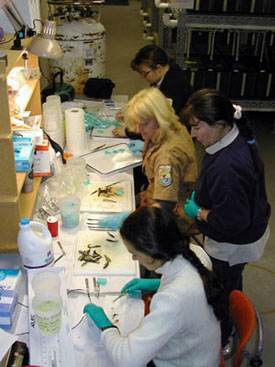 |
This difference in dwelling areas as well as spawning habits is certainly troublesome.
“Cutthroat provide a nutrient link to rest of the environment,” Bigelow said. “The cutthroats are surface-oriented, whereas the lake trout are in deeper water. This could mean trouble for lots of other animals.”
Recent counts of fewer grizzlies showing up to fish for cutthroat are anything but encouraging.
Lake trout are much larger and more aggressive than cutthroat trout, able to eat fish up to half their size. They eat thousands of cutthroat trout annually with one lake trout consuming almost 50 cutthroat trout every year.
Park officials recently stated in their annual fisheries report publication that lake trout “have the potential to decimate the Yellowstone Lake fishery in our lifetime without heightened and maintained management efforts.”
Whirling disease is also heavily taking its toll on mainly young cutthroats, the same base of prey for the bigger, more aggressive lake trout.
“The interesting thing about whirling disease is that it’s very prevalent in some waters and tributaries and non-existent in others,” Bigelow said. “But that doesn’t mean it isn’t a concern.”
Whirling disease is caused by the myxobolus cerebralis parasite. Researchers believe it originated in Europe and are not sure how it founds its way into Yellowstone’s waters.
The parasite infects the nervous system of the cutthroat trout, making its way through the brain stem and causing black tail, whirling (which makes the infected fish unable to feed and swim normally and more vulnerable to predation), and sometimes death, especially if the fish is infected at a young age.
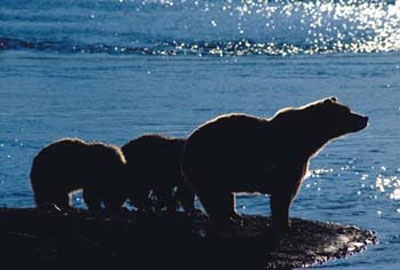 |
A grizzly bear and her cubs fish for cutthroat trout in Yellowstone Lake. The bear is only one of nearly 42 species that rely on the native fish as a main food source (Photo courtesy of Tom Smith, U.S. Geological Survey). |
“It doesn’t take a lot of contact with the parasite for the fish to become infected,” said Vincent. “Young ones are so vulnerable, if they get a light infection it can compromise general health, but severe infection can cause death before three months of age. When affected so young, mortality rates are extremely high—near 95 to 99 percent. Light infections are harder to pick up and directly trace their negative effects because they really just compromise the general health of the fish as well as its swimming abilities and abilities to escape pray.”
As if getting eaten by bigger, fiercer fish and crippled by a degenerative parasite weren’t enough, the drought then causes more problems for the struggling cutthroats. The drought causes low water levels, which make cutthroat even more vulnerable as prey and makes the spawning process less successful. It also cuts off young cutthroat trout from the rest of the waters’ populations as tributaries and waterways dry out.
“It’s a triple threat,” said Bigelow. “You’ve got not one, not two, but three things working in unison against one shrinking population.”
Vincent agreed that cutthroats could easily withstand the drought alone: “But when you add the lake trout and whirling disease, the combination of those together could be way more severe than if it was one without the others.”
Now the question is, though there may be no identifiable beginning or end to these problems for the cutthroat trout, what is being done to fight off these negative forces that are decimating such an important species?
Though the drought may be an issue only cured by time, the removal of lake trout and the whirling disease parasite require more concentrated efforts.
Efforts to remove lake trout have been ongoing since the discovery of the species in 1994. Large and aggressive and environmentally strong, these stubborn lakers haven’t been easy to get rid of.
The main tactic for lake trout removal is a process the park started in 1996 called gill-netting, which involves laying massive nets in certain lake areas to extract the lake trout.
| A park worker demonstrates the gill netting process. Gill netting has been used since 1996 in the effort to eradicate lake trout from Yellowstone Lake (Photo courtesy of Western Parks and Wildlife). |
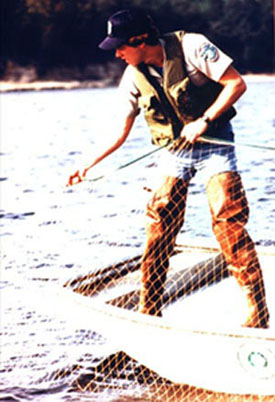 |
“Every year we are able to fine tune it a little more and improve our efforts,” Bigelow said of the gill-netting process. “The older lake trout though are not as vulnerable to gill-netting year round because where they swim matches up with where the cutthroats swim and we surely don’t want to net and kill any of those.”
Nash said he has faith that gill-netting has been and will continue to be successful.
“Our fisheries biologists have told me they feel like we are having some success. It’s always going to be an issue for us. But we are pretty aggressive with it and getting more focused on breeding time and grounds and targeting deeper waters as well as spawning areas specific to the lakers.”
Those working to extract the lake trout have recently been aided by detailed imagery technology installed on the boats.
“The imagery has really detailed GPS and maps,” Bigelow said. “It’s amazingly helpful. It’s like a fish finder for a recreational boat, but when you combine it with the GPS unit and have the entire map of the lake, ridges and all, laid out, it really helps you target and fine tune net placement so that your nets are very precise.”
Though Bigelow expressed that they don’t have solid data on the exact number of lake trout in Yellowstone Lake, she said the population is still growing, but that recent rates of growth have definitely decreased due to continued and improved gill-netting.
Efforts to rid the waters of whirling disease have been underway since it was discovered in the lake in1998.
Though there is no known way to eliminate the parasite, Yellowstone researchers are working hard to understand where, how and why the parasite originates, why cutthroats seem extremely vulnerable to infection, and how to stop the further spread of the disease.
Whirling disease will continue to be a problem for Yellowstone’s cutthroats as well as other trout and salmon varieties in various waterways, and though eradication of the parasite is very unlikely, progress has been made.
New ultraviolet water-filtering devices that can eliminate the parasite in hatcheries have been developed. Recent research has also indicated that there are usually “hotbeds” or concentrated areas of the disease, which are easier targets for elimination efforts. And finally, researchers in Montana found success by imprinting trout eggs with a colder spawning temperature, helping them mature more quickly past the period where they are most susceptible to the parasite.
The efforts are expensive.
“We definitely have a good budget to work with,” Bigelow stated.
According to Richard Emlet, a marine zoology professor at University of Oregon and specialist on invasive species, this surge of funding to protect native species from invasive predators has recently become commonplace.
“Worldwide, invasive aquatic species have had devastating impacts on resident populations and sometimes on fisheries,” Emlet said. “Recently, in the past 10 years, introduced and invasive species in marine and aquatic habitats have come to the forefront as topics for research. There is substantial funding to find, identify and understand or predict the impact of these species because of their potential to do so much damage.”
Besides allocating funds for the research and eradication of lake trout and whirling disease, the park has come up with certain guidelines to help sustain the cutthroat population as well. These include requiring those fishing in the park to kill any lake trout they catch and throw back any cutthroat trout they catch. They also urge park visitors to turn in or report any fish they catch that seem to be infected with whirling disease to aid in research efforts.
When asked if they were trying to expand the cutthroat population on top of trying to eliminate lakers and whirling disease, Nash responded that fisheries biologists were doing their best to maintain and improve the health of all the waterways cutthroats thrive in to enhance the population.
| Two trout are laid beside each other to compare the harmful and fatal effects of whirling disease (Photo courtesy of Oregon State University). |
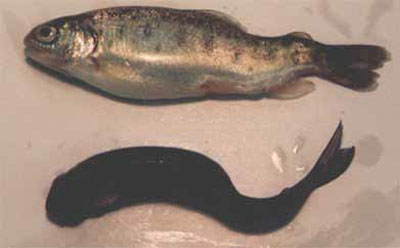 |
However, according to Bigelow, any actual effort to artificially expand the cutthroat trout population would be harmful. “You would mess up the genetics in any type of hatchery situation and end up doing more harm than good,” Bigelow said.
“There are certainly a lot of people concerned with the issue,” Bigelow replied when asked if citizens or interest groups had shown any interest in the decline of cutthroat trout.
The East Yellowstone Chapter of Trout Unlimited is working on a campaign to save the cutthroats that anyone can get involved in even if it is just by contributing money.
“It’s so important to preserve native species that keep the park’s ecosystem in tact. We want to save and preserve the cutthroat,” said Bob Capron, president of the East Yellowstone Chapter of Trout Unlimited.
Individuals and businesses seem to agree that sustaining this population is important.
Tim Wade, owner of North Fork Anglers, which is located almost 60 miles from Yellowstone Lake, understands just how important and explained his feelings to Billing’s Gazette, a publication located in Montana and Wyoming.
“Yellowstone cutthroat is a very crucial part of that environment, very crucial. And to have it jeopardized or threatened in any way is a good way to spend money, or volunteer money, or donate money to eradicate the money and restore the native cutthroat population,” Wade told the paper.
Though it may be a battle the park has been fighting since the mid-1990s, there is no sign that efforts to remove the negative effects of lake trout, whirling disease, and the drought are going to be given up on. In fact, it is just the opposite. Efforts are stronger, better researched and more heavily funded than ever before.

Comments are Closed